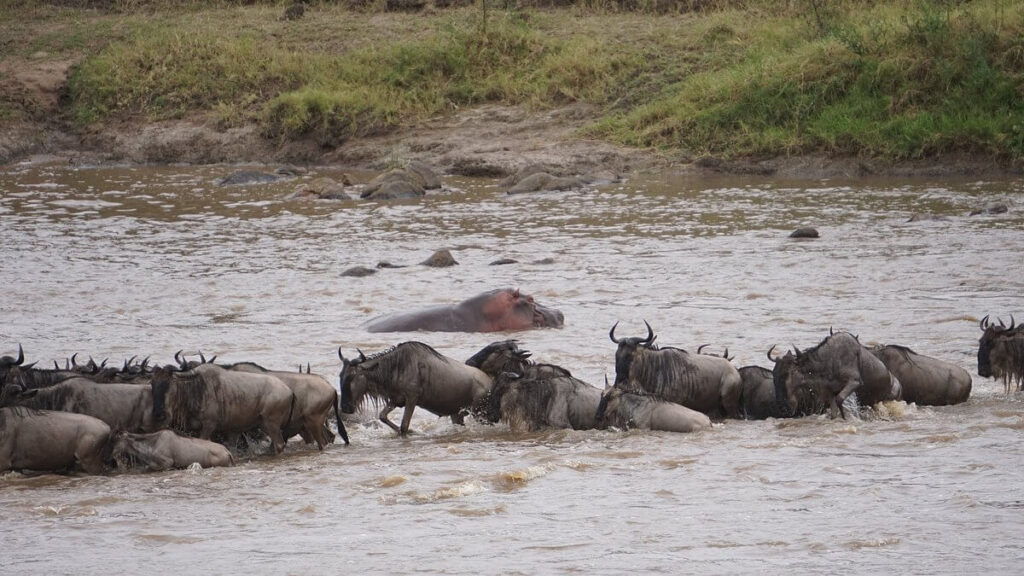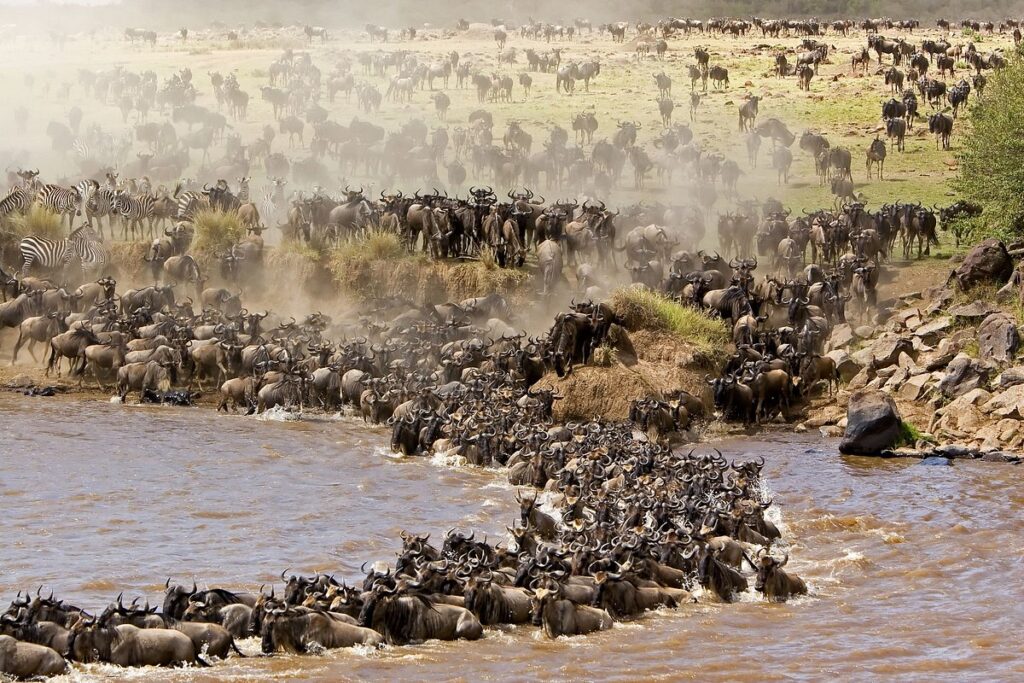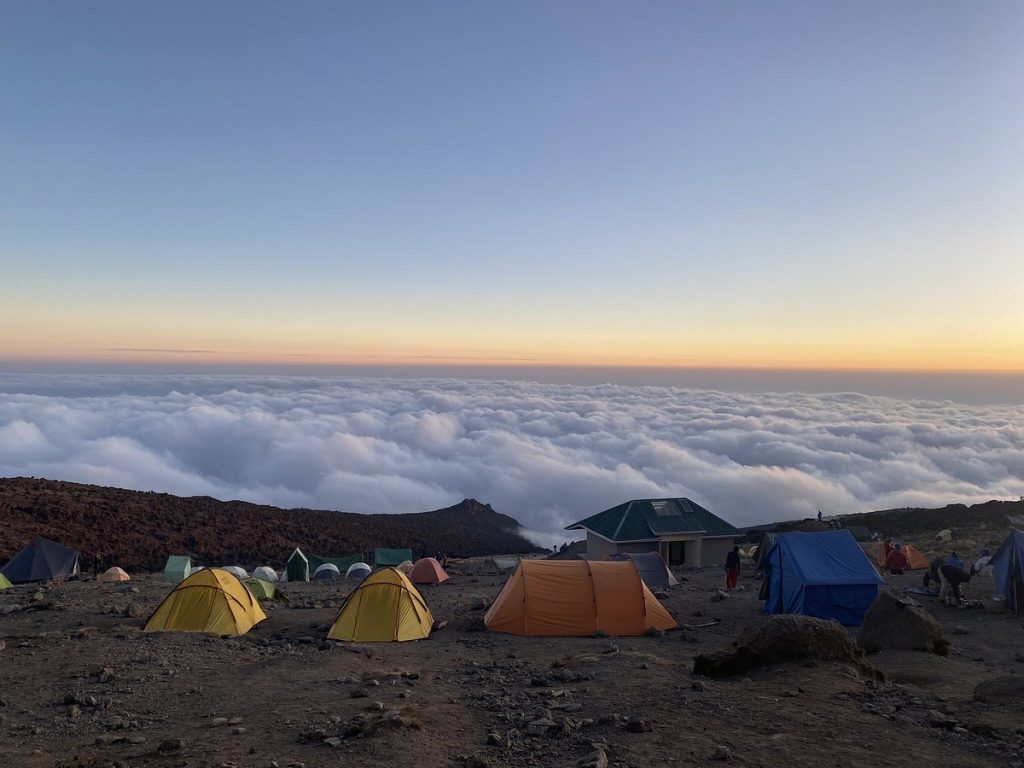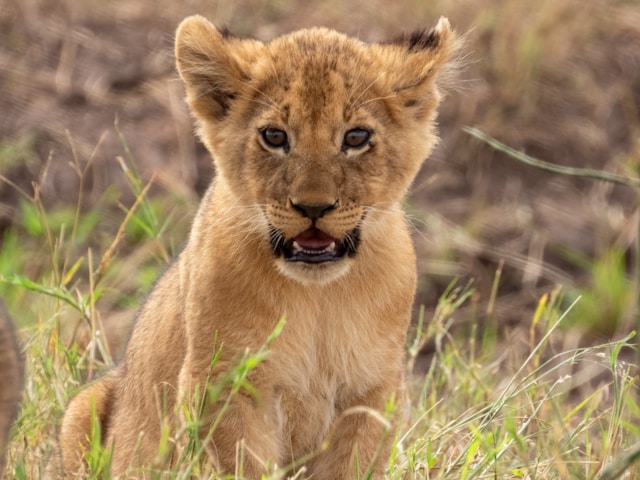Serengeti National Park famous known as Serengeti plains which covers 14, 763 sq km, is Tanzania’s most famous game park and is continuous with the Masai Mara Game Reserve in neighboring Kenya. Here you can get a glimpse of what a lot of East Africa must have looked like.
On the seemingly endless and almost treeless plains of Serengeti are literally millions of hooded animals. They are constantly on the move in search of pasture and are watched and pursued by the predators which feed off them. It is one of the most incredible sights you will ever see and the numbers are simply mind-boggling.
Serengeti Wildebeest Migration
Nowhere else will you see wildebeest, gazelle, zebra, and antelope in such concentrations. The wildebeest, of which there are up to two million, is the chief herbivore of the Serengeti and also the main prey of the large carnivores such as lions and hyenas.
The wildebeest are well known for the annual migration which they undertake- a trek with many hazards, not least of which is the crossing of large rivers, which can leave hundreds drowned, maimed, or taken by a crocodile.
During the rainy season, the herds are widely scattered over the eastern section of the Serengeti and Masai Mara in the north. These areas have few large rivers and streams and quickly dry out when the rain ceases.
When that happens the wildebeest concentrate on the few remaining green areas and gradually form huge herds which move off west in search of better pasture.
At about the time the migration starts, the annual rut also begins. For a few days at a time while the herds pause, bulls establish territories, which they defend against rivals, and try to assemble as many females as they can with which they mate. As soon as the migration resumes, the female herds merge again.
The dry season is spent in the western parts of Serengeti, at the end of which the herds move back east in anticipation of the rains. Calving begins at the start of the rainy season, but if it arrives late, up to 80% of the new calves may die from lack of food.
Serengeti is also famous for its lions, many of which have collars fitted with transmitters so that their movements can be studied and their location is known.
It is also famous for cheetahs and remarkably large herds of giraffes. You need to bring a pair of binoculars with you to this park, as the distances are so great you will probably miss out on a lot of the action unless it occurs close to the road.

Detail Serengeti Great Migration
The yearly 800km movement of more than 2.5 million animals, the biggest mammalian migration on earth, is what gives the Serengeti its revered status in the human mind. The migration, a continuous, unorganized mass that includes close to two million wildebeest and a million or more other animals, provides viewers with one of nature’s most breathtaking spectacles, one in which the ever-vigilant predators—lions, cheetahs, African hunting dogs, and spotted hyenas—play a crucial role.
The biggest challenge is crossing rivers, particularly the Grumeti in the Serengeti and the Mara along the northern border with Kenya, which can both be the scene of real carnage as panicked herds attempt to cross the raging flows in a writhing mass of bodies while the weak, hurt, or careless are picked off by crocodiles and lions. The constant movement of the migratory is caused by a seasonal hunt for fresh water and pasture that is governed by the rainfall.
The migration travels essentially in a clockwise route, concentrating in the national park from April to June, at the conclusion of the lengthy rains, before leaving the Serengeti’s withering plains and heading north to Kenya’s Maasai Mara Game Reserve, where the new wetness and grass are found in August. The majority of the migration is focused in Maasai Mara between September and October.
The Mara’s grasslands are nearing exhaustion by late October or early November, so the migration retreats to the northern and eastern Serengeti, following the new grass that the brief rains provided. The migration is dispersed extensively during this time, and a significant portion of it travels via Loliondo and into Ngorongoro, past the eastern edge of the Serengeti.
The migratory makes its home in the Serengeti Plains and western Ngorongoro from December to March, where it stays until the start of the long rains. Every year, the wildebeest give birth to half a million calves by taking advantage of this brief hiatus (particularly from late January to mid-March). The time of this mass birthing offers protection in numbers: predators will get their fill, but in a few months, the remaining calves will be stronger and able to evade their pursuers; nonetheless, the risks of the migration are such that only one in three calves returns the following year.
By April, the Serengeti is once again the center of the migration, and the cycle repeats itself. Coinciding with the migration cannot be assured (Contact Jolita Safari for More Details) because its precise timing and location change every year depending on the weather and other variables. The best months to view the migration in the Serengeti, however, are typically December to July, particularly in the plains between February and March when the wildebeest herds are speckled with newborns, and from April to June when animal numbers are at their maximum.
The migration’s risky crossing of the Grumeti River is best observed in June, and the majestic Mara River crossing, which can also be seen in the northern Serengeti, is best observed in July and August.

The Serengeti Park
The Serengeti plains and its kopjes, Seronera in the center, the Western Corridor, and the north make up the four main sectors of the Serengeti National Park. Each merit at least a half-day, therefore two or three days are advised overall to see a little bit of everything. When approaching from the east, the route from Ngorongoro Crater to the center of the Serengeti is a lengthy game drive in and of itself, cutting across the Serengeti Plains. Numerous kopjes, or worn granite outcrops, are dispersed over the plains. They are little ecosystems that offer some shelter and a small amount of water in puddles left in the rock by rainstorms.
Serengeti Balloon Safaris
Serengeti National park is also one of the parks in Tanzanian where you can take a hot air balloon flight organized by the balloon specialist and this can be booked at and arranged with Jolita Safari.
Viewing a game park from the vantage point of a hot-air balloon is a magnificent experience that you won’t ever forget. The experience of floating silently above the plains with a 360-degree view of everything beneath you, without safari jeep/vehicles competing for the photo opportunity, is incomparable. It is definitely worth saving up for!
The wildebeest migration is a captivating occurrence that is perplexing and somewhat upsetting from the ground as you observe individual struggles and events. A hot-air balloon looks like an ant’s nest from the air. Balloon safaris are the height of rustic style, costing $ 599 for adults and $ 449 for children for the one-hour or longer flight that includes a champagne brunch. The Serengeti park’s balloon inflation and lift-off operations take place around dawn in Serengeti Ndutu in the south, Serengeti Seronera in the center, or Serengeti Kogatende in the north. The landing is, to put it mildly, usually interesting because the basket may be dragged along before coming to rest.
They will pick you up from any of the central lodges or campgrounds before dawn, so you don’t have to remain at the hotel to fly. There are only two balloons companies, Nyssa Balloon, and Serengeti Balloon so it is better to book in advance with Jolita Safari.
After that, you will be taken on a game drive in a support vehicle and returned to your lodge. At present, these flights are available in Serengeti Ndutu in the south, Serengeti Seronera in the central, and Serengeti Kogatende in the north part of the park and they depart daily.
Balloon safaris in the game park are an absolutely superb way of seeing the savannah plains and of course the animals but without the intrusion of vehicles and dozens of other tourists doing the same thing. Contact us today and we can assist you to book your best balloon safari over the Serengeti National Park
Ngorongoro to Serengeti Route
The main route from Ngorongoro to Seronera village is a well-maintained gravel road with sandy and the occasional Skopje to one side or the other. A 3 hours drive and 160km drive you will see plenty of Maasai herding cattle from Ngorongoro as far as the Olduvai Gorge.
The animals are also very easy to see, as the Serengeti is substantially flat grassland with bushes and trees only in clumps, particularly along river banks. This park is rich in wildlife and probably the best safari destination in the world. Contact us to book a safari to Serengeti and experience the best wildlife view that will stay in your memory forever.



